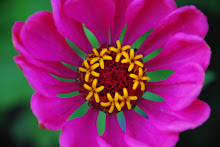 Dear Friends,
Dear Friends,It was a beautiful afternoon & evening in the garden with sun and clouds and warm weather (mid 50's). The birds were singing and I was in pure bliss. Here's my cat Jack really enjoying the lavender I harvested from the garden! Today was a great day to prune and clean up all of my perennials and herbs. They were looking pretty messy from the winter. So I got rid of all the dead stuff to make room for new spring growth. And there were signs of spring rebirth everywhere with new growth on favorites like agastache, centranthus, crocosmia, lavatera, penstemon, bronze fennel, lavender, mauve chives, lemon thyme, purple sage...very exciting.



My blueberries have just developed buds and they range in color from white to pink to red. They are just beautiful. The first photo is 'Briggata' the second is 'Top Hat' and the third is 'Sunshine Blue.' I gave them a boost with some liquid seaweed and homemade blend organic granular fertilizer. Their next door neighbors are last year's strawberries. (Which I didn't get any photos of) The strawberries are beginning to leaf out so I gave them a haircut and clean-up of all the dead leaves left from the winter. Better to throw the dead leaves in the compost bin where they will break down quicker than around the strawberries where slugs can hide out. The strawberries also got a does of liquid seaweed. Yum-yum!
I planted seeds directly in this raised bed today. The soil was hardly wet at all despite this week's rain. It was the perfect consistency for planting seeds today. Since I had prepped this bed in the Fall with a good dose of compost, earthworm castings, coir, and organic granular fertilizer it was ready to go. And no weeds either because it had a layer of wood based compost on the top as winter mulch. I hoed the mulch in just a little to make it easier for the seeds to germinate. I did not till this bed because I don't like to disturb the soil microorganisms. I work very hard to nurture healthy soil life by adding all kinds of organic matter, growing legumes & cover crops, mulching, and only using organic methods. I feel that tilling in raised beds is an unnecessary and harmful practice. Excessive tilling destroys soil life which leads to unhealthy plants, disease and pests. Ok, so once I hoed a little I was ready to plant seeds. I only seeded half the bed because I'll do the other half in about 2 weeks. It's great to succession plant your greens and root crops over the course of the spring to reap the longest harvest during the summer. Today I planted from seed: 'cherry belle' radish, arugula, 'white lisbon' scallions, 'tendersweet' carrots, 'salad bowl' lettuce, 'purple top white globe' turnips, mache, feverfew and salad burnet. I also planted 'walla walla' onions from bunches. You can maybe see them in the photo tucked in behind the kale. And, of course, I watered in my seed with seaweed extract. There were a couple of existing plants in this bed that I seeded around: bottom right corner is a 2 year old oregano, 3 dinosaur kale plants along the back that overwintered, and to the left one cilantro plant that overwintered.
It was a great afternoon in the garden today. While working I felt serene, productive and hopeful. I felt super in touch with my soil and with nature. The warm air, the sunbreaks, plus the new growth on plants made me feel like it was really finally spring!
In Health,
Miss Jolie Ann



 Hi friends!
Hi friends!

















